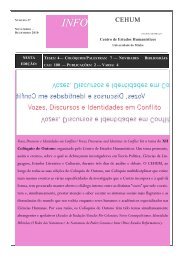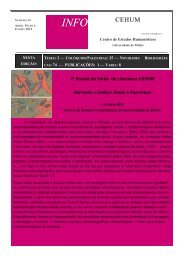Diacritica 25-2_Filosofia.indb - cehum - Universidade do Minho
Diacritica 25-2_Filosofia.indb - cehum - Universidade do Minho
Diacritica 25-2_Filosofia.indb - cehum - Universidade do Minho
You also want an ePaper? Increase the reach of your titles
YUMPU automatically turns print PDFs into web optimized ePapers that Google loves.
70<br />
CLAUDIA REITINGER<br />
responses for examples of that kind. If we are in a position in which we cannot<br />
avoid harming another person, l as in the example above, it makes no<br />
sense to demand that we should not harm a person. To demand the impossible<br />
contradicts the principle ‘ought implies can’. According to the threshold<br />
conception the <strong>do</strong>ctor harms the patient but in this case his action is<br />
not morally wrong. Similar to this example are all cases, in which a person<br />
already is below a certain threshold and an agent cannot better the situation<br />
for this person, however, not bringing him above the threshold. Because the<br />
threshold notion <strong>do</strong>es not imply that an agent is obliged to better a person’s<br />
condition below the threshold, Meyer supplements the threshold conception<br />
by the requirement to minimize harm. Th is means that we are obliged<br />
to better the condition of a person although he is below the threshold.<br />
Th e second objection is more severe. According to the threshold notion<br />
of harm in many cases, which we normally assess as harming, no harm is<br />
<strong>do</strong>ne. Th ese include all actions, which lead to the worsening of the situation<br />
of people without bringing them under the threshold. Let’s suppose I am<br />
very rich. My neighbour hates me for this. He destroys the fl owers in my<br />
house entrance, scratches my car or steals my credit cart and goes shopping<br />
on my costs. In all this cases according to the threshold notion my neighbour<br />
<strong>do</strong>es not harm me. We have to refer to the subjunctive notion of harm<br />
in this class of examples. For that reason Meyer states that the threshold<br />
conception alone is not suffi cient to defi ne harm. Because of the Non-Identity<br />
Problem the subjunctive notion is not suffi cient as well, Meyer proposes<br />
to combine the latter two as a disjunction. Th e subjunctive notion (III) and<br />
the threshold notion (I) are understood as providing alternative necessary<br />
conditions for harming. Or, in other words, the disjunction of (I) and (III)<br />
is a necessary condition of harming.<br />
(IV) (disjunctive) An action (or inaction) harms a person only if either<br />
(I) this action causes the quality of life of that persons to fall below a specifi ed<br />
threshold and, if the agent cannot avoid causing harm in this sense, <strong>do</strong>es not<br />
minimize the harm; or (III) if the agent causes (or allows) this person to be<br />
worse- off at some later time t 2 than the person would have been at t 2 had the<br />
agent not interacted with (or acted with respect to) this person at all (Meyer,<br />
2005: 56.). [3]<br />
3 T he translation from German to English is based on Meyers article ‚Intergenerational Justice’ in<br />
the Stanford Encyclopedia of Philosophy<br />
<strong>Diacritica</strong> <strong>25</strong>-2_<strong>Filosofia</strong>.<strong>indb</strong> 70 05-01-2012 09:38:21



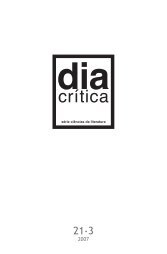

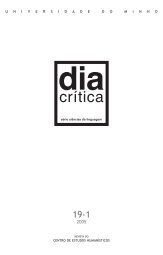



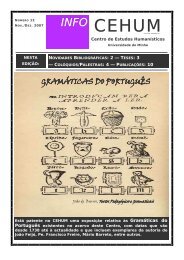

![Programa [pdf] - cehum - Universidade do Minho](https://img.yumpu.com/17305425/1/190x135/programa-pdf-cehum-universidade-do-minho.jpg?quality=85)


